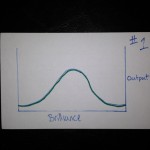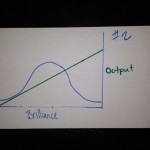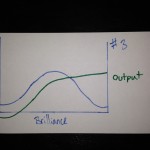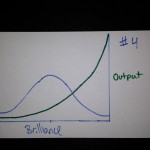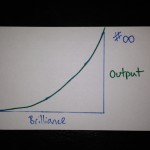I just watched the movie ‘Tim’s Vermeer’ In which inventor Tim Jenison sets out to paint a replica of Johannes Vermeer’s painting ‘The Music Lesson.’ You can see Vermeer’s painting and Jenison’s work here.
The film was mind blowing, but not because Jenison was able to produce a near masterpiece quality work in his first significant painting. What was mind blowing was the unbelievable level of focus and dedication that Jenison put into the project, which took over five years from start to finish. Jenison spent over 200 days just replicating the scene from The Music Lesson in his San Antonio workshop – crafting the woodwork, the windows, the designs on the harpsichord – everything that was needed to reproduce the famous painting in 1:1 scale.
Then he spent over four months painstakingly painting the scene using his custom camera obscura. Four months leaning over a mirror and with brush and oil, dabbing bits of color onto a canvas. The detailed knots on the carpet alone took him over a month to replicate.
And Jenison is not an artist. He’s a tech inventor and multi-millionaire who had an obsession with Vermeer. The man spent years of his life researching and re-creating the technology Vermeer probably used, spent seven months reproducing the scene Vermeer painted and then spent over four months of cramping work hunched over a canvas using that optical technology just to prove a point.
I find this level of effort, dedication, creativity, insight and focus far more intriguing than anything about Vermeer’s technique.
Quite honestly, I think if I had Jenison’s wealth, I’d probably be on a sailboat somewhere writing sci-fi and reading everything I could get my hands on, not re-inventing a long-lost 300 year old optical art technique and then using it to replicate the work of a world master (or some equivalent obsession).
That reminds me of a story I heard about a senior investment banker and a junior associate. One evening at the bar after a long day at the office, the associate asked the banker how much he was really worth. The banker said casually ‘oh, about a hundred million.’ The associate said ‘holy shit, a hundred million dollars?!? That’s a fortune. Why don’t you retire and go relax on a beach somewhere? Isn’t that enough?’ The banker downed his martini, looked the associate straight in the eye and said ‘people who think there’s enough will never have a hundred million dollars.’
True enough.
It got me thinking about a recent conversation where we discussed the concept of elitism. People generally accept that the IQ/intellect/capacity of society generally falls along a bell curve, where most people fall in the middle or within two standard deviations, and only the exceptionally bright or exceptionally dull fall on the tailing fringes. An egalitarian explanation of their relative contribution to society, what I’ll call ‘Output’ would fall generally along the same bell curve. (Brilliance is some cumulative combination of IQ, persistence, focus, work ethic and all the other qualities that describe productive intellect.)
#1
A more elitist view would argue that the least brilliant contribute almost nothing, while there is a steady increase as you go up the brilliance scale.
#2
I’ve always thought this isn’t quite right. The worst among, the hard core thieves, con artists and slackers actually subtract output from society. Then the output generally mirrors the slope of the increase in brilliance, but instead of dropping off with the bell curve, slowly continues to increase. The more brilliant you get, the more output you produce per capita.
#3
However, watching Tim’s Vermeer got me thinking that the relationship is really like this:
#4
What if the most brilliant among us actually produce more output/value/intellectual advancement than the combined total of the masses behind them? What if they actually produce multiples of the other 99%?
Take Elon Musk as an example. At age 43 the man has revolutionized the online payment industry and is in the process of revolutionizing the car industry and the space launch industry. His motivation for the latter? He wants to make the human race an interplanetary species. He drew the line from here to there and realized he’d need to completely re-invent the way spaceflight works. He works 80-100 hours a week, smart people describe him as the smartest person they’ve ever worked with, he devours information, surrounds himself with brilliance and once he sets his mind to doing something, he will not consider failure.
And he does it.
Has Elon generated as much value as the bottom million on the US bell curve? Certainly.
The bottom 10 million? Quite possibly.
Imagine that – one person generating as much nebulous value as millions of people.
Reading about Elon Musk and watching Tim’s Vermeer make you realize that there are some truly extraordinarily gifted people in the world who have a unique combination of intelligence, drive, passion, focus, dedication and resources that enables them to accomplish results that are orders of magnitude greater than the average person. Take away one of those key attributes and they might be merely average.
There’s probably someone smarter than Elon who loves video games and is sitting on his couch smoking pot.
There’s certainly people more driven, but who don’t have the intelligence and wind up working manual labor their whole lives.
There’s probably someone in the developing world who has all his talents, but is lacking the resources to accomplish much of anything.
For me, there’s no real question that the output curve lies somewhere between #2-#4. The real question is how do we as a species identify these super-achievers and ensure they are provided with an environment that is conducive to producing these unbelievable results?
And perhaps more importantly, how do we create the conditions for humanity where we can unlock everyone’s potential so that their output always measures up to their potential?
This is where we need to be:
Pushing the bell curve into a geometric acceleration is the future of mankind.
Tags: bell curve, brilliance, Elon Musk, genius, singularity, Tim Jenison, Tim's Vermeer

